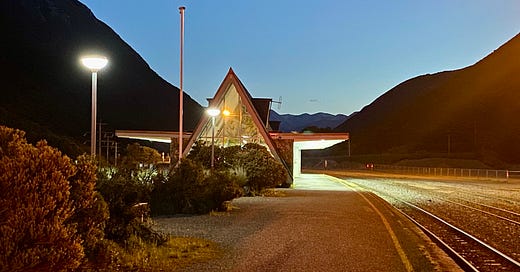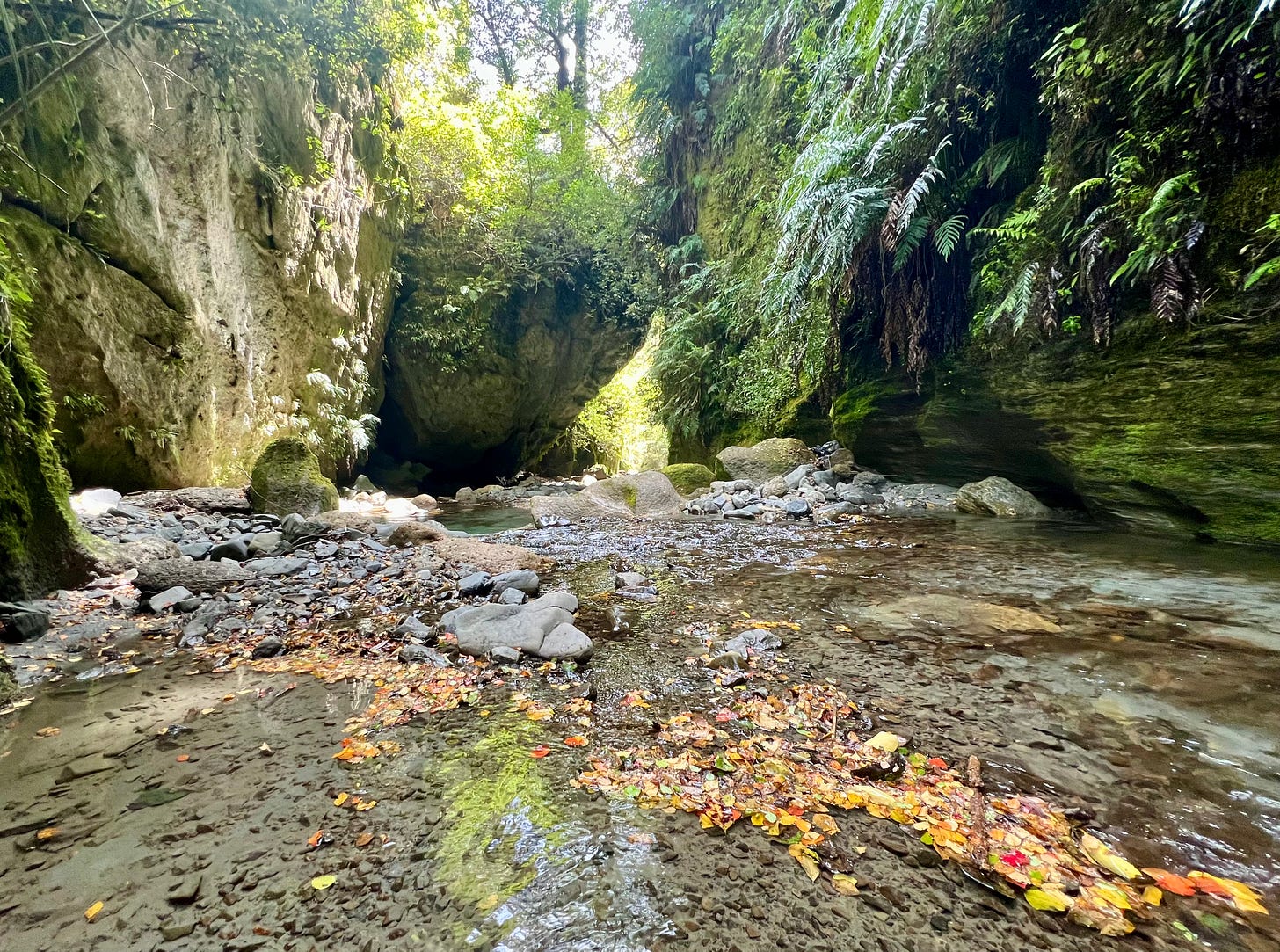December’s post on the future of the InterIslander rail ferry service prompted a spirited email exchange between us — radio broadcaster Bryan Crump and A↬I editor Dave Heatley. We decided to share the edited highlights.
[Bryan] As a fan of rail transport (although I think my enthusiasm falls short of the criteria for "foamer" status) the medium-term prospect of freight trains disappearing from the North Island Main Trunk (NIMT) fills me with some dismay.
I am wise enough to appreciate just because I like something doesn't mean it ought to stay. The Raurimu Spiral and the many viaducts through the central North Island would make for a remarkable cycle trail.
[Dave] Thank you for introducing me to the term “foamer.” [Foamer “describes someone who is obsessed with trains. Not just a railfan, but beyond that.”]
It may surprise you, but I’m train fan. I’ve relaxed on the Northern Explorer, visited the Raurimu Spiral and the viaducts near Ohakune on the ground, and – just last month – enjoyed commuting on the Capital Connection.
I try to put all that aside, however, when I look at the economics of rail. Rail freight just isn’t paying its way – it costs much more to run KiwiRail than its customers are willing to pay (its customer revenue was ~$850m in 2022/23).1 Government makes up the difference in lots of ways – non-customer flows into KiwiRail totalled ~$1.5bn in 2022/23. It’s legitimate to ask what are taxpayers getting for that money? And is it being spent wisely? What other social priorities could it be applied to? Could it have greater overall benefits in another use?
[Bryan] Delighted that I may have extended your vocabulary!
Your graph of rail's share of land transport in the 21st century initially showed a steady increase, peaking at 20% in 2010, before beginning its steady decline to its current share of 15%. Why was rail's share increasing in the 2000s, and what happened in 2010?
I'm guessing 2010 is about the time the impact of the Key Government's policy to allow more axles on truck trailers began to kick in. That possibly increased driver productivity by up to 50%.
[Dave] That’s one possible explanation. Another is that road freight is more sensitive to NZ GDP fluctuations than is rail, so what we saw 2007-11 was a post-GFC depressive effect on road freight, which pushed up the share of rail freight. Once the NZ economy was back to “normal,” the underlying trend reasserted itself.
Unfortunately, the fidelity of the underlying freight data is low, making it hard to distinguish between these theories and others.
[Bryan] For rail to maintain the same productivity advantage (what a train driver can move compared to a truck driver), it would have had to increase the axle load its rail lines are capable of handling. I think KiwiRail's standard is currently 18 tonnes per axle. By comparison Queensland Rail (which also runs on 1067mm gauge track) is 26t.
[Dave] NZ rail is different in important ways from what happens overseas. I admit to gazing in awe at trans-Canada freight trains in 2018 – they are up to 4km long, with double-stacked containers! KiwiRail is never likely to achieve that level of efficiency.
[Bryan] NZ's rail operators frequently complain they have to fund all of their capital investment in a permanent way, while central government is prepared to put billions of dollars into new roads.
[Dave] Yes, that’s the complaint. But it is demonstrably wrong. Most of the capital expenditure (CAPEX) on roading in NZ is funded by road users, with smaller amounts from taxpayers (via central government) and ratepayers (via rates). Rail generally fails to cover its operational expenditure (OPEX), receiving top-ups from road users via the National Land Transport Fund. Rail CAPEX mostly comes from taxpayers via central government.
[Bryan] The last significant investment in the NIMT was the electrification project (not so much the electric locomotives, but the millions put into improving the railway itself). That was completed in the late 1980s. Billions have been spent on improving State Highway 1 since then.
Is current transport infrastructure funding giving road transport too much of an advantage?
[Dave] There is a more than reasonable case for the opposite viewpoint, that is, road users are subsidising rail (see above).
[Bryan] Is it possible private motor vehicles are also subsidising heavy trucks (pothole problems anyone) and if they are, might they want that subsidy directed towards getting some of the road freight back onto rail?
[Dave] I think there is one good reason why road users should subsidise rail. This is because road users benefit when rail takes trucks off roads. The question in my mind is not whether there should be subsidies, rather it is what level of subsidy is reasonable? In economics, too much subsidy is just as wrong as too little.
[Bryan] You make a convincing argument that we are already subsidising a significant chunk of our rail freight operations. But I'm not convinced taxpayers aren't doing a little bit of the same when it comes to road wear from heavy trucks. However, the recent election result suggests most voters are quite happy to see more of their taxes going to fix potholes.
Treasury gave advice to the Key government to close most of the KiwiRail system in 2015. More recently, an EY study (launched by the recently deposed Labour-led government) concluded rail's net national social/economic benefit was being underestimated to the tune of billions.
Who's right?
[Dave] Economic valuation is an imprecise science, and reasonable people can come to different conclusions. (That said, in my experience consulting firms have a remarkable ability to produce an answer that the firm thinks the customer wanted.)
Even if EY is correct, and “rail’s net national social/economic benefit was being underestimated to the tune of billions,” that doesn’t mean that every proposal to spend money on rail makes economic sense.
The Interislander ferry and port upgrade (iReX) may well have been a good deal if it could have been completed at the initially mooted ~$700m. But that doesn’t mean it was a good deal at ~$3bn — a point on which Ministers Robertson and Willis agreed. And it almost certainly wouldn’t have been a good deal at say $6bn (which it could have easily ended up at, should it have blown out like Auckland’s City Rail Link).
Does being against iReX at a price tag of $3bn make one anti-rail? I don’t believe so. I just think iReX was a poorly designed and executed project that reflects very badly on KiwiRail’s governance and management. They chose to ignore an obvious option that would have given them two rail ferries at a much lower cost: retaining the rail ferry Aratere (fewer than 10 years have passed since its last rebuild) and buying a single custom-built rail ferry that was compatible with existing port facilities.
[Bryan] I agree that the evidence from the impact of the Kaikoura earthquake, and the subsequent layoff of the Aratere ferry (which left KiwiRail with no rail ferry for the best part of a year), suggests New Zealand can cope just fine without the rail ferry link.
However, it's also clear that, when the rail ferry option is no longer there, the share of freight going by rail on the NIMT will decline.
What if global concern about climate change forces governments in the 2030s and 40s to rapidly decarbonise? If we no longer have an integrated rail network, will we regret not being able to pivot more quickly?
[Dave] I don’t think that an “integrated rail network” is a binary thing. A better goal for NZ is an integrated freight network, where freight can travel by the mode, or combination of modes, that meets the delivery time and other requirements of freight customers at a reasonable price (and has externalities like congestion and emissions properly — but not excessively — factored in).
Just because I think that iReX at $3bn was a bad deal for the country, doesn’t mean that I would conclude the same thing for different projects. I suspect there may be a reasonable case for rail infrastructure upgrades between Tauranga and Auckland, for example. Each project should be looked at on its own merits, rather than by appeal to a higher cause like “integrated rail network.”
[Bryan] Or are we confident our trucks will all be electric by then?
[Dave] If trucks are not electric, then rail may not be much help, as it is very poorly suited to moving many loads – e.g. livestock, concrete, and quarried materials. Moreover, most non-bulk rail trips still require a truck to get the load to/from the railhead.
Once we have electric trucks at reasonable prices that can take on the tasks rail cannot move, those trucks will also compete with rail for the tasks it can move. This might make the economics of rail more difficult, rather than easier, from the 2030s onwards.
Reducing greenhouse gas emissions is important. But that doesn’t mean that every project that purports to reduce emissions is worthwhile.
[Bryan] Alas, it appears NZ is neither big enough, nor has sufficient population density for rail to really thrive, with a few exceptions.
Perhaps the future is three separate rail networks:
Auckland/Hamilton/Tauranga, including the forestry and dairy industries of South Waikato and the Bay of Plenty, and the (as long as it remains open) steel mill at Mission Bush.
Wellington/Masterton and Palmerston North.
Christchurch/Dunedin/Invercargill and (as long as we continue to export West Coast coal to steel mills overseas) the West Coast.
[Dave] This is pretty close to what I and others have been saying for quite a while. For example, I wrote 15 years ago:
In 2006/07, 30% of the network (Auckland, Waikato, Bay of Plenty, Canterbury and West Coast) carried 70% of freight. These are also the areas with the majority of future predicted increases in demand... This should form the ‘viable core’ of the future rail network. The South Island Main Trunk from Canterbury to Otago (and possibly Southland) could also be viable.2
[Bryan] Still, I can't help wondering "what if" rail freight had attracted a little more government investment; would a rail line to Marsden Point (coupled with an upgrade of the Northland line) have done for Northland what the Kaimai Tunnel did for the Bay of Plenty?
Your post on the demise of Three Waters made the point that local government tends to delay investment in sewage and storm water because it's not noticed by voters (until it fails).
Did rail freight infrastructure suffer a similar fate? No politician has suffered promising another motorway!
[Dave] The electoral consequences of motorway commitments are perhaps not quite that simple. The incoming Labour government didn’t suffer any obvious electoral consequences for cancelling Auckland’s East-West link motorway in 2017. I think the parties craft their appeals to different electoral bases.
I predict that NZ will still have a rail network in the 2030s. The parts that thrive will be determined by customer demand to move a limited number of (mostly bulk) commodities, just as it is now. The parts that don’t have much demand (e.g. Napier to Wairoa) will continue to wither, regardless of how much capital the government is willing to pour in.
[Bryan] I wonder how ruthless the current government will be? If the Aratere is our last rail ferry, will it allow KiwiRail to divest of its unprofitable routes? Or will KiwiRail be lumbered with maintaining loss making lines, because the Government isn't prepared to close them? Or will Nicola Willis find a cheaper rail ferry option?
[Dave] I am sure there are cheaper rail-ferry options than iReX. But the government faces some tough decisions without clear answers. I can only hope these are informed by solid analysis. But I guess we’ll have to wait to find out.
[Bryan] Regardless of the economics, I would be sad if trains disappeared from the NIMT. But being able to cycle up the Raurimu Spiral and across the Makatote Viaduct would be a significant consolation.
By Dave Heatley & Bryan Crump
These figures are approximate. They are based on my (Dave’s) reading of the financial accounts presented in KiwiRail Integrated Report 2023.
Dave Heatley (2009). The history and future of rail in New Zealand. ISCR Working Paper. Institute for the Study of Competition and Regulation.











I enjoyed the joust. And loved the missing “h” in the title! This is further to my supportive comments on Dave’s original article.
Road User Charges (RUCs) were introduced on 1 April 1978, a month after I replaced John Becket (who had been seconded from the railways!) as the PM’s transport adviser. RUCs were motivated by the desire to make trucks pay their way.
The railways had long argued that rail paid for its own RoW whereas trucks were free riders on private motorists. In essence this had been correct. But no longer.
RUCs comprised three components: guidance, space and wear.
The cost of pavement wear fell on trucks. Heavy axles wear out pavements. Alternatively expressed, heavy axles demand stronger pavements. Pavement wear by a truck was assessed for the licensed gross weight (chosen by the owner) and the axle configuration supporting that weight. Truck owners could reduce RUCs by choosing to have more axles. There was a trade-off between extra axles and reduced payload.
Space refers to road capacity, the ability to handle the volume of traffic. Traffic was measured in Passenger Car Units. (Car 1 PCU. Motorcycle 0.5 PCU. Truck a few PCUs.) Costs of road widening, climbing lanes, alignment straightening, etc were spread on a PCU basis.
Guidance was an assortment of lesser costs such as road signs and markings that were spread per vehicle.
Trucks were fitted with hubodometers and paid RUCs per 1,000km (in advance) for their travel. Petrol powered cars paid via a levy on fuel. (Diesel cars paid RUCs.)
Although there is a lot of averaging in the RUCs it did mean that the trucking industry as a whole was paying for provision of, and use of, the nation’s roads. Tanker operators complained they were paying too much. The RUCs system assumed they were always at their licensed weight when in fact their back-hauls were empty.
So, wither the argument that rail is disadvantaged by providing its own RoW!
Where to from here? Massive quantities of coal in Queensland and iron ore in Western Australia travel from mine to port in unit trains and on tracks owned by the private sector. Moving these quantities by truck is unthinkable-- until one sees it actually happening in southern Mongolia! (Thousands of articulated trucks crossing the desert bumper-to-bumper.)
But NZ doesn’t have such transport demands, other than perhaps logs.
As an aside, the odd thing is that road pavements within the forests are built to State Highway standards yet the logging rigs using those pavements can be 120 tonne, and even 140 tonne gross weight—over twice the maximum allowed on State Highways. Word of caution: don’t forget bridges, which perform differently to pavements.
As for rail’s 18 tonne maximum axle weight, it is low. But would investment in heavier gauge rail be economic? And can the existing viaducts, bridges and culverts withstand the increased loads? If the benefit:cost ratio were favourable the private sector could invest.
I need to study the EY report to comment on it. But a quick look leaves me puzzled. I read: “Modelling assumes that all new trucks on the road consistently carry 9.6 tonnes and does not attempt to adjust for empty return trips.” I thought one of the issues was big trucks (payload 30 tonne or more) smashing pavements. And I wonder whether truck trips to/from rail heads were tallied.
I was today years old when I found out what NIMT means, after seeing it at Wellington station all these years 😅